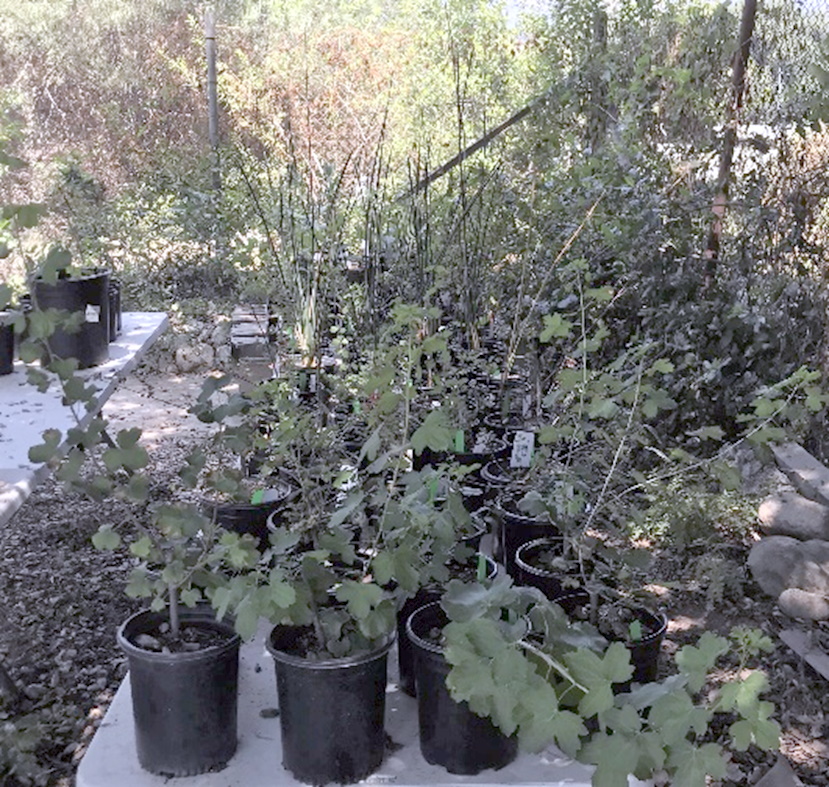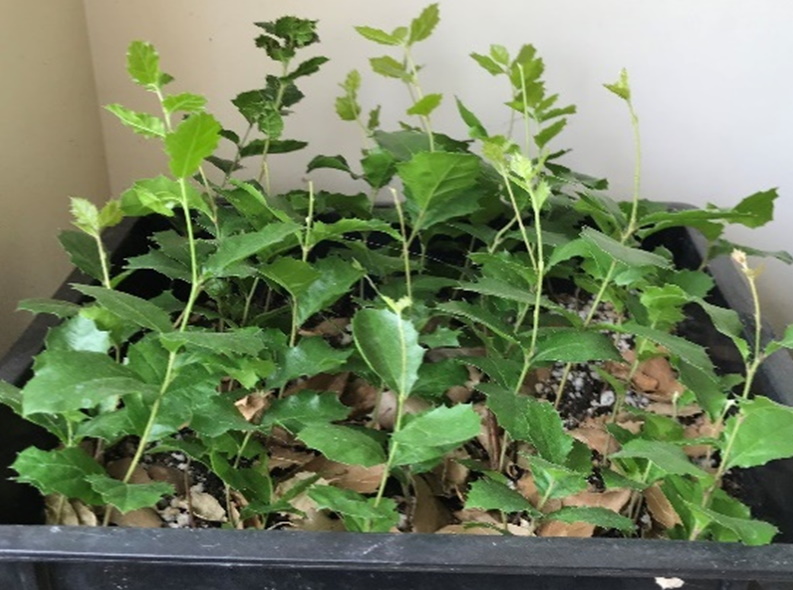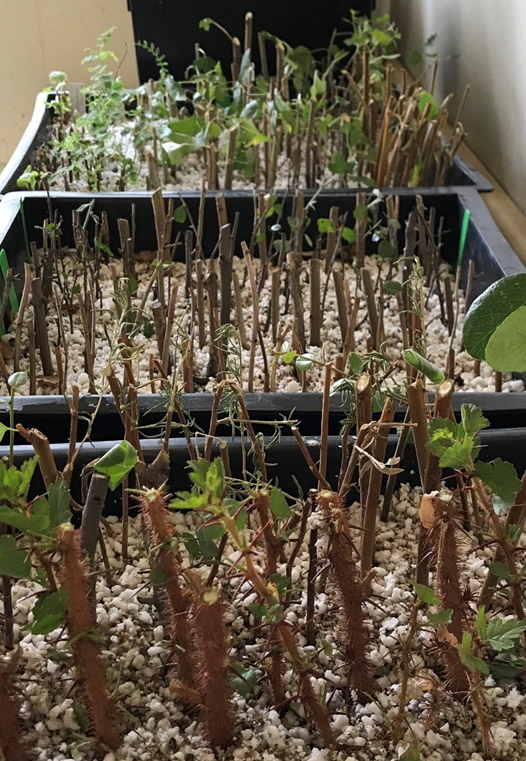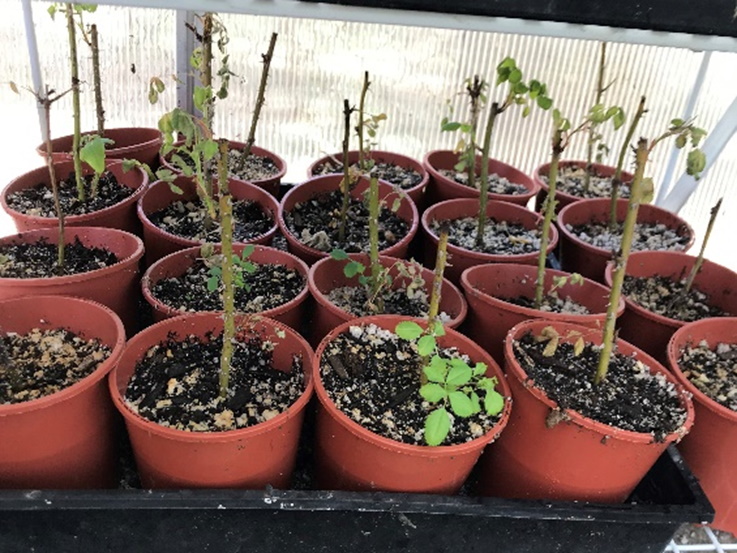Native Plants for Berkshire Creek Restoration
Propagation Report for the Berkshire Creek Project
The Hahamongna Native Plant Nursery is abuzz with activity for the Berkshire Creek Project. Scouting parties have located source material for plants and seeds. Source material has been collected for cuttings that have grown into 4"plants and then potted up into 1 gallon containers. Seeds have been collected and are being processed. And the cycle continues as more source material is needed for other plants and seeds.

The plant lists for the three project areas have been combined into one master Berkshire Creek plant list. On it there are 81 different plant species of those 40 are plants and/or seeds while 39 are seeds only. The remaining two species are Salix spp. (Willow) and Opuntia vaseyi (Prickly Pear) which will be planted as cuttings or pads. Of the source material to be planted we have scouted 65% of the species locally. Of the source material that is only seeds, 33% of the species have been scouted locally. More scouting activities have been planned for the remaining species with volunteers in July and August. A majority of the over 300 plants in containers are one gallon in size.
Quercus agrifolia (Coast Live Oak) acorns were collected in the fall. Richard Lewis of Psomas donated Q. engelmannii (Engelmann Oak) acorns. After refrigerating them for cold stratification, they were sowed in March. Unfortunately, the ground squirrels and blue jays found the saplings a tasty treat. Remaining Q. agrifolia acorns were sown and protected from predators. The nursery already had Q. engelmannii under cultivation. So all was not lost.

Much source material has been made into cutting trays, including Amorpha californica (CA False Indigo), Ribes speciosum (Gooseberry), Rhamnus crocea (Spiny Redberry), and Brickellia californica (CA Brickellbush). More source material has been scouted and plans for return visits to collect cuttings have been planned, including Dendromecon ridiga (Chaparral Bush Poppy), Umbellularia califonica (CA Bay), and Rubus ursinus (CA Blackberry). Source material that still needs to be scouted include Dudleya lanceolate (Lance-leafed Dudleya), Rhus aromatica (Shunk Bush) and Scrophularia californica (CA Figwort). A customer, while hiking found D. lanceolate seedlings and brought them to the nursery. These transplants have yet to thrive. There are a total of five trays of cuttings. Each tray holds over 100 cuttings, for over 500 cuttings. Additional cuttings are in the outside planter beds. The planter beds will be covered with shade cloth for the summer. Irrigation timers have been installed on the outside beds. The indoor trays retain water longer so only need to be hand watered.

In addition to cuttings, some of the plant species can be grown from division. Rosa californica (Wild Rose), is just such a plant. Here are 20 4" plants made from division of a plant local to the watershed. Symphoricarpos mollis is another plant that can be grown by division, there are 20, 4" plants and will be repotted into 1 gallon containers soon.
Almost all of the plants and cuttings have been pest free. Recently on Baccharis salicifolia (Mulefat), red aphids have been seen both on our plant stock as well as on the plant in the demonstration garden. An organic insecticide, PyGanic Gardening, Botanical Insecticide Pyrethrin, recommended by Greg Rubin, CA native landscape gardener and author, has been purchased. The affected plants have been isolated and one application. Has been completed.
As plants go to seed, seed collection has increased. Some of these include Lupinus succulentus (Arroyo Lupine), Pseduognaphalium californicum (CA Cudweed) and Sages; S. apiana (White Sage), S.Mellifera (Black Sage), and S. columbariae (Chia). Many of the seeds yet to be scouted are annuals. But the time for collection of many of these species has passed. Seed processing is a rewarding and time-consuming process that will resume during the dog-days of summer.
Currently, the main focus is working on the Berkshire Creek plant list. Plant propagation and production is a fluid situation as well as a numbers game given that not all seedlings or cuttings become viable plant stock. The staff and volunteers at Hahamongna Native Plant Nursery are confident that plants will be delivered on schedule. The results of the current seed sowing and plant cuttings will be available for the September meeting of the Berkshire Creek Team Meeting.
July 2019
— Portia Besocke
